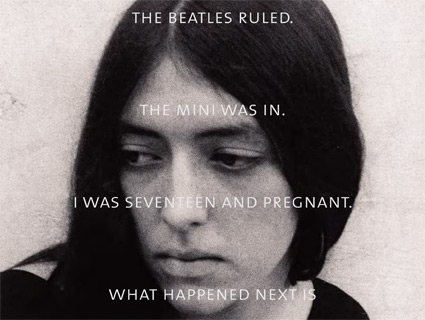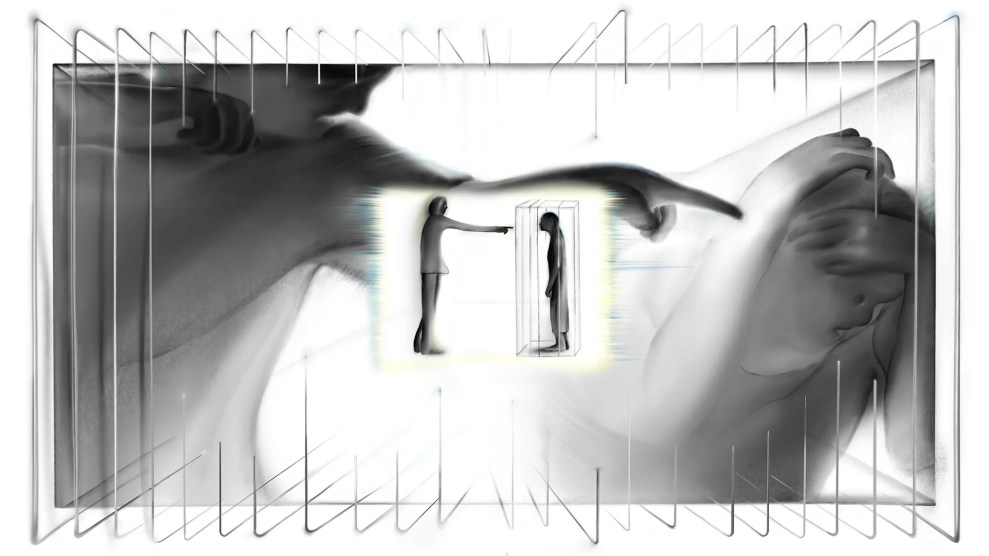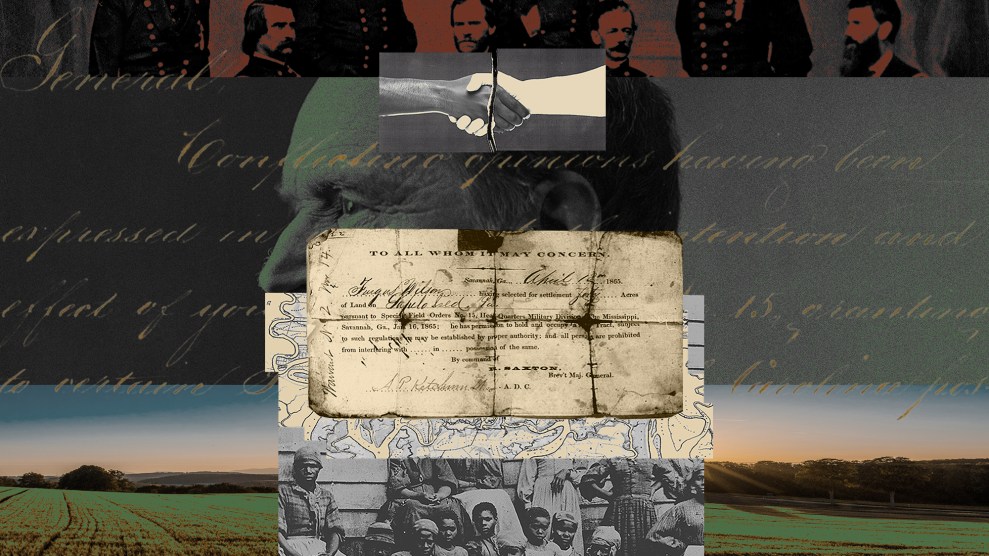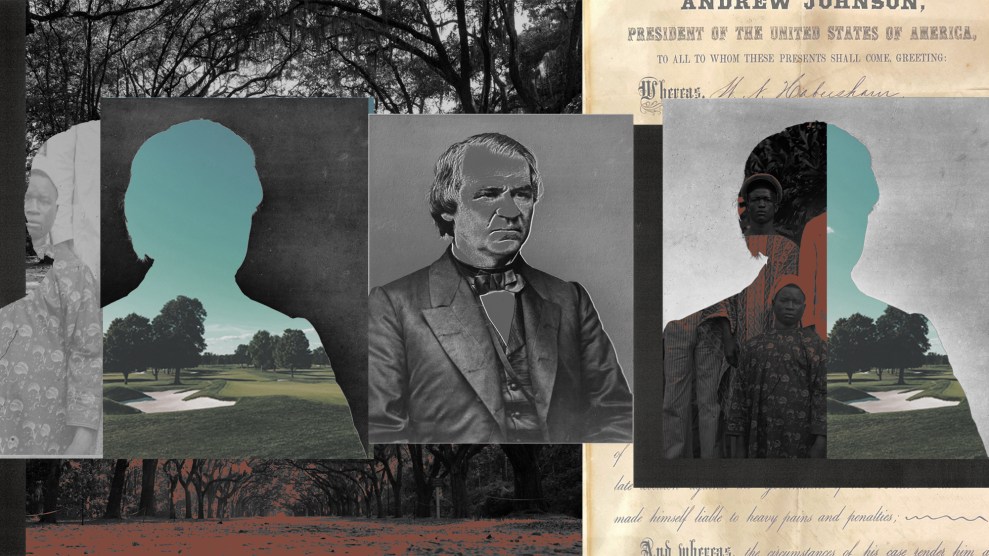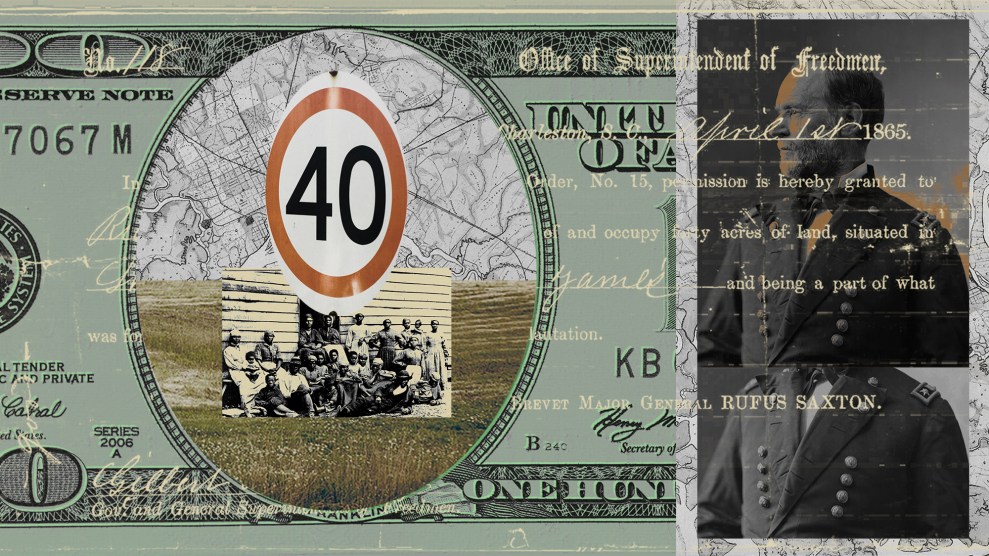The old days of coat-hanger abortions will never come back, we reassured ourselves as Roe was repeatedly threatened over the years. Even once the Dobbs decision handed the power to regulate abortion to the states, we told ourselves there would be no return to bleeding out on motel room floors or back alleys, now that most abortions can happen discreetly and safely at home, thanks to the abortion pill mifepristone.
But beware: Modern American Puritans who sit on judicial benches and state legislatures are going after mifepristone and even contraception. How? By jolting new life into an 1873 federal anti-obscenity law that has lain dormant for decades—the Comstock Act. The act criminalized contraceptives, abortifacients, sex toys, pornography, or sexual content (including medical advice), making it illegal to send such items via the US mail and eventually any means of interstate conveyance.
“I knew about Comstock before Dobbs, but I wanted to say nothing about it,” anti-abortion legal mastermind Jonathan Mitchell told the Nation’s Amy Littlefield in the spring of 2023. “I really was hoping no one would say anything about the Comstock laws until Dobbs came out.”
Dobbs accomplished, Mitchell and the other moral crusaders seized on Comstock with relish. Mitchell used it to challenge local “sanctuary” laws protecting abortion rights, and others permitting teens from getting access to contraception without parental permission. District Judge Matthew Kacsmaryk of Texas cited the Comstock Act to challenge the FDA’s 24-year-old approval of mifepristone. That case is now before the Supreme Court, where Justices Thomas and Alito brought Comstock up in oral arguments. Even if the court does not take this opportunity to resurrect Comstock (given the vast implications for the entire medical regulatory landscape), Mitchell and his ilk are launching a volley of cases citing the act, all but ensuring that the court gets another chance. “From my standpoint, I want to get Comstock to the Supreme Court as quickly as possible,” Mitchell told Littlefield.
So what is the Comstock Act? Many of us have heard of it, if only vaguely. We may also have heard the term “Comstockery,” defined as the “strict censorship of materials considered obscene” and “censorious opposition to alleged immorality,” and know that it was coined by playwright George Bernard Shaw.
The occasion was the removal of Shaw’s Man and Superman from the shelves of the New York Public Library in 1905. Taking umbrage and spotting an opportunity, Shaw fired back, announcing his intention to bring “Mrs. Warren’s Profession”—a play that had been banned in London for its frank discussion of prostitution—to New York, telling the city’s papers, “Comstockery is the world’s standing joke at the expense of the United States. It confirms the deep-seated conviction of the Old World that America is a provincial place, a second-rate country-town civilization after all.”
Anthony Comstock, by then America’s leading moralist, hadn’t heard of Shaw until the playwright’s words were published in the papers. He did a little quick brushing up and fired back, calling Shaw an “Irish smut peddler” and alerting the New York police to the dangerous content of Shaw’s play. He also wrote a huffy letter to Shaw’s producer Arnold Daly, calling “Mrs Warren’s Profession” “filthy” and quoting, with an ominous tone of warning, recent court decisions in obscenity cases. Daly, a savvy publicity man, did not let the opportunity go by. He sent Comstock’s letter to all the papers, along with an exquisitely civil response inviting Comstock to come to a rehearsal.
The result? Ticket sales went through the roof, and the play was sold out weeks before the curtain went up. The police were called forth on opening night—not to raid the play, but to dispel the overflow mob in the streets clamoring to get in. Score one for GBS.
But this was but one defeat in a long career of victories, for by then Comstock had already enjoyed decades of unimaginable power. His crusade against “obscenity” had driven abortion underground (which lasted until Roe v. Wade in 1973), and resulted in a ban on using or distributing birth control (which lasted until Griswold v. Connecticut in 1965). But while it had been reined in, the Comstock Act remained on the books, burrowing underground like a cicada, awaiting the Puritans of our day to revive it.
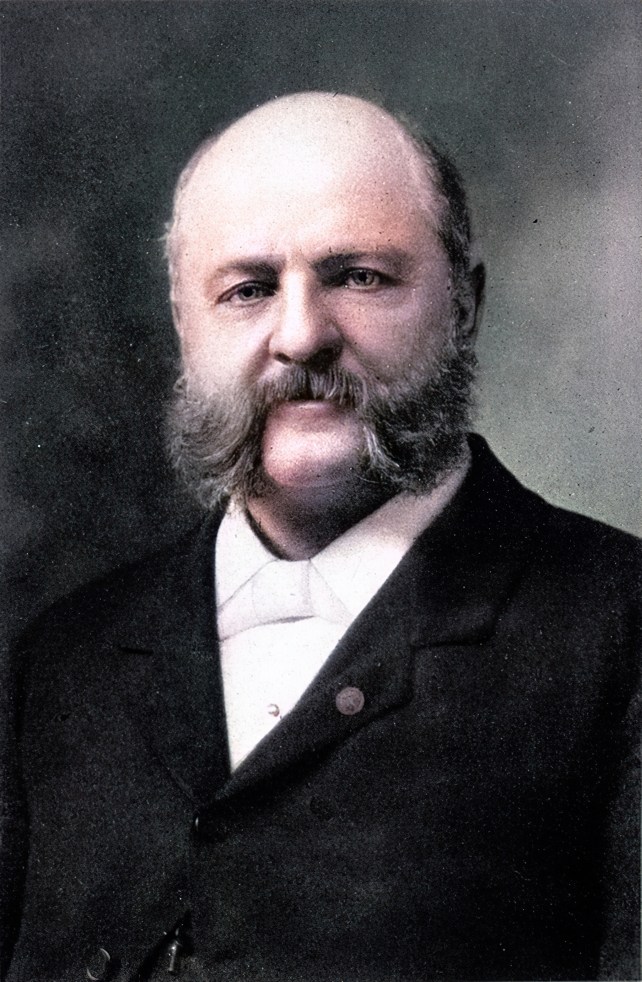
Anthony Comstock, 1913.
Gado/Getty
Comstock was born in 1844, in New Canaan, Connecticut, the son of a well-to-do farmer father and a mother who gave birth to a total of 10 children. The Comstocks were both of unbroken Puritan lineage, and Anthony and his siblings were reared in the austere tradition of the Congregational church. Bible stories were the bedtime fare, and Anthony’s mother, Polly, who died when he was 10 (of complications from childbirth), tended to choose stories of moral heroism and beating back Satan, a very real presence who lurked everywhere with his inventory of earthly temptations.
By the time Comstock was 18, he broke into the establishment of a man who traded in liquor without a license, and opened faucets and smashed kegs with an axe. As a finishing touch, he left a note saying that the guy had better quit his business, because next time the building would burn.
Not many of us find our footing in life so early, decisively, and definitively. Decades later, he’d still be known for his physical courage. Even his bitterest detractors (and he had many) couldn’t deny that he was fearless, that he was no mere paper-pusher waging moral war from the safety of an office, pulpit, or armchair. He had a real taste for conducting raids hands-on and in person when and where he could, in-your-face and two-fistedly, sometimes in the worst slums that 19th century New York had to offer, sometimes on Fifth Avenue. His career was checkered with wild stories of kicking in doors, brawling, throwing and receiving punches, being pushed down stairs and slashed with knives.
A couple of years after that first temperance raid, Anthony joined the Union Army, and was stationed in a relatively quiet corner of Florida where his unit seems to have sat out the fighting. This gave him plenty of time to read the Bible and ruminate. Comstock made a show of pouring his ration of whiskey on the ground instead of giving it to someone who could use it, and he was oddly unprepared for the realities of life among big groups of men. Not only were the men drinking and swearing, but they were passing around a dog-eared copy of Fanny Hill: Memoirs of a Woman of Pleasure. Comstock’s Army diaries are full of anguish over the “low and brutish” conversation of the soldiers; he refers to the barracks as the “Den of Cursing and Blasphemy.” One early entry reads: “Have been twitted several times today about being a Christian. Would that I were a better one.” He moans constantly about his own tendency to slide down the slippery slope and onto the Devil’s waiting prongs: “Again tempted and found wanting. Sin, sin. O, how much peace and happiness is sacrificed on thy altar….O, I deplore my sinful weak nature so much…” Sometimes he gives in, though he deprives us of the details: “This morning were severely tempted by Satan and after some time in my own weakness I failed…Rather welcome death than sin.”
The Seventeenth Connecticut Regiment had no chaplain of its own, so Comstock took it upon himself to find a clergyman. You get the feeling that the men were less than grateful for his efforts. A subsequent diary entry records an altercation following a detail to unload a cargo of “Coffee, Sugar and Whiskey:” “Boys got very drunk, I did not drink a drop, and yet some were going to whip me. Knocked two over and kept on at duty. Touch not, taste not. Handle not.” Not long after, he writes: “Seems to be a feeling of hatred by some of the boys, constantly falsifying, persecuting and trying to do me harm.” Then, a few days later, an incident that possibly sealed the fate of many a Comstock adversary for years to come: “Moved up into a room alone by myself. After meeting went to go up into room, all windows were closed tight, room full of smoke. Bunk full of rubbish and loaded with broken Benches, Chairs, etc. Boys were initiating me.” It should be noted that the “initiation” at the hands of the “boys” took place after he’d been in their company for almost a year.
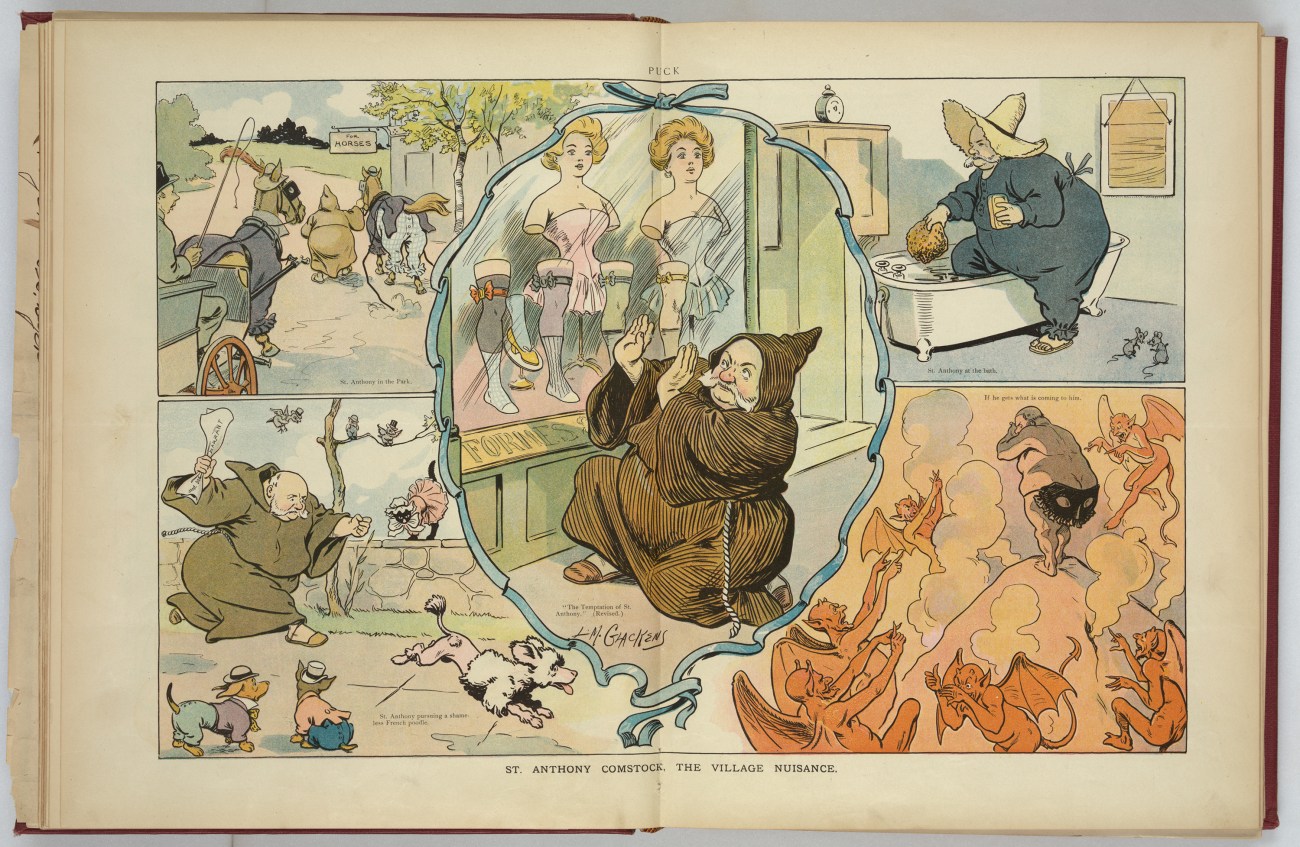
Illustration by L.M. Glackens depicts the “St. Anthony Comstock, the Village Nuisance” from Puck, 1906. The cartoon depicts Comstock as a monk thwarting shameless displays of excessive flesh, whether that of women, horses, or dogs, with a “Jane Doe Warrant.”
Library of Congress
New York after the Civil War was a seething place. Wars tend to have a steroid-like effect on the winning society, and this war was no exception—the north had retooled itself and kicked into high-gear productivity to feed the war machine. When the war ended, the machinery stayed in motion, and things got crazily productive and dizzyingly prosperous. Railroads got built. Fortunes got made and lost in a sort of mad frenzy. And people, in a giddy fit of joie de vivre, did what people usually do after a war: They drank, they danced, they fornicated.
Art, music, theatre, and literature were thriving in a new age of frankness and sophistication. Women were starting to talk about being allowed to vote. Free Love was in the air, with high-minded proponents, of both genders, many of them fresh from the abolitionist movement, writing and speaking about it in public. There were educated, articulate women like Victoria Woodhull who were talking both politics (she declared herself a presidential candidate in 1870) and the radical notion of the right of women to enjoy sex without the constraints of marriage and without the consequence of pregnancy if they didn’t want it. Scientists, doctors, and “reform physiologists” were beginning to study sex and to talk and write candidly about it, to publish “marriage instruction” manuals and such, and to invent and promulgate devices for the prevention of conception. Newspapers and catalogues carried advertisements for such items as “French Protectors” and “womb veils,” as well as various “menses restoratives.” Abortionists abounded, operating out of everything from rundown boarding houses to opulent mansions, and with a full range of patrons, from the highest to the lowest ranks of society.
Street life was robust and rowdy. Hard liquor flowed, and there were prostitutes, brothels, pool halls, and “pretty waiter-girl” saloons. Pornographers aplenty were churning out erotic pamphlets, books, pictures, and postcards—and hordes of young men, migrating to the city, living unsupervised in boarding houses and hotels, partaking of it all.
Such copious, society-permeating upheaval meant, inevitably, a backlash, a revival of old-time Puritanism. By 1866, the YMCA had circulated a manifesto of sorts, with this catchy title: “A Memorandum Respecting New York as a Field for Moral and Christian Effort Among Young Men; Its Present Neglected Condition; And the Fitness of the New York Young Men’s Christian Association as a Principal Agency for Its Due Cultivation.”
H.L. Mencken would write later that “the new Puritanism is not ascetic, but militant. Its aim is not to lift up saints, but to knock down sinners.” New York, with its richly variegated society of sin, and its would-be reformers of sinners, was like a stage set waiting for its star performer to stride forth. Enter Anthony Comstock, who moved there to work as a dry-goods salesman. If he thought life in an Army barracks was low and brutish, just wait until he saw what awaited him in New York.
The youth who’d smashed whiskey barrels and knocked drunken soldiers off their feet soon found that being a dry-goods clerk did not quench the fire in his belly. He struggled to stay motivated in his work. He did well in spite of himself, though, was rapidly promoted, and got married to a woman 10 years older than he, but something was lacking.
There were already anti-obscenity laws in place in New York, as in most of the northeastern states. Statutes against “obscene daguerreotypes and ballads” went back to English common law in the colonies, and in 1815 a landmark case in Pennsylvania indicted “evil-disposed yeomen” for exhibiting a “lewd, wicked, scandalous, infamous and obscene painting” in a private house. By 1865 it was illegal to import “indecent” pictures and articles into the United States or to send them through the mail.
But the laws were about as effective as a Band-Aid on a hemorrhage. Comstock, whose work put him in close association with a lot of other young men, was disturbed by their appetite for erotic books and pictures and by how plentiful and easily available the stuff was. By 1868, he’d had a couple of dealers of such material arrested, pulling a sting operation in at least one case (he would later develop the sting into a fine art and use it over and over)—posing as a consumer, buying an erotic pamphlet, and then turning the purveyor in to the authorities. A few years later, in 1871, outraged over the violation of a law requiring saloons to shut down on Sunday, he called the cops in on the offending proprietors. One of the officers Comstock accosted on the street was less than cooperative at first, but changed his mind after Comstock threatened to report him.
Comstock’s diary records deep satisfaction: “I am determined to act the part of the Good Citizen and wherever a man breaks the law I will make him satisfy the laws’ demands if in my power.” He laments the corruption of those who should be enforcing the law, and declares that he lives in a “murderous” age, that crime “stalketh abroad by daylight” and “Public officers wink at it.” “Money can buy our judges and corrupt our juries,” he writes. “But God helping me, it shall never buy or sell me. I believe Jesus would never wink at any wrong nor would he countenance it.”
Comstock the street fighter is born, and his confrontations with saloon-keepers get up-close and personal. One guy’s establishment, which enjoys police protection, was just a block or two from Comstock’s house in Brooklyn. The battle is on: Comstock persists in his righteous harassments, calling on the chief of police and the mayor of New York. The saloon-keeper stalks Comstock and issues death threats. Comstock buys a gun. He brandishes it and scares off the saloon-keeper temporarily, then goes to court and gets warrants for his arrest. Comstock hauls witnesses into court, endures delays, spies on the saloon, questions patrons on the street, petitions the judge, is threatened by “drunk and Boisterous” men holding rocks in their hands as Comstock passes by the saloon on his way to church with his wife, but he will not be intimidated or deterred, and in the end, drives the offending saloon-keepers out of business.
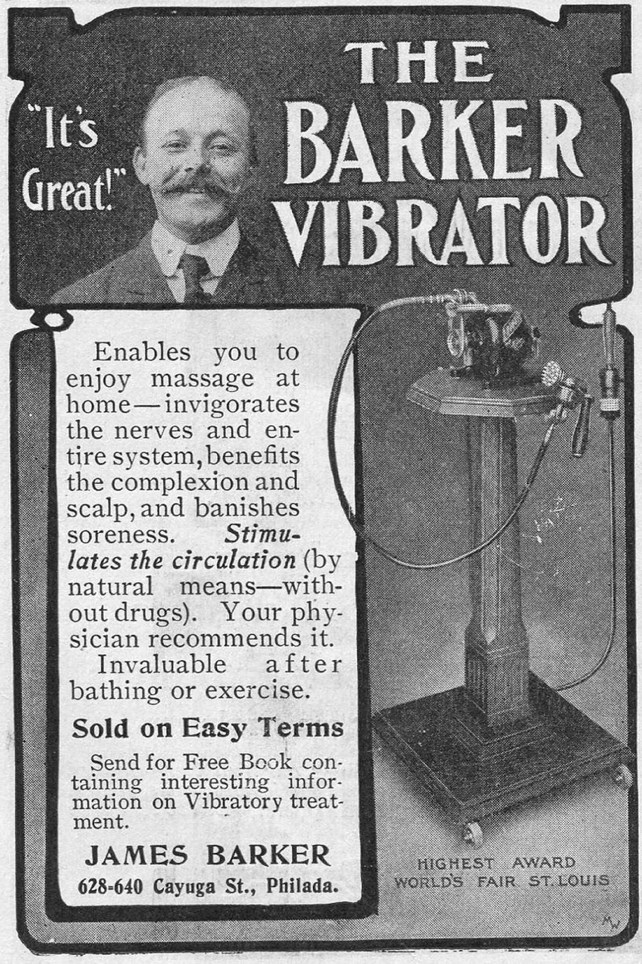
Advertisement for the Barker Vibrator by James Barker in Philadelphia, 1906
Jay Paul/Getty
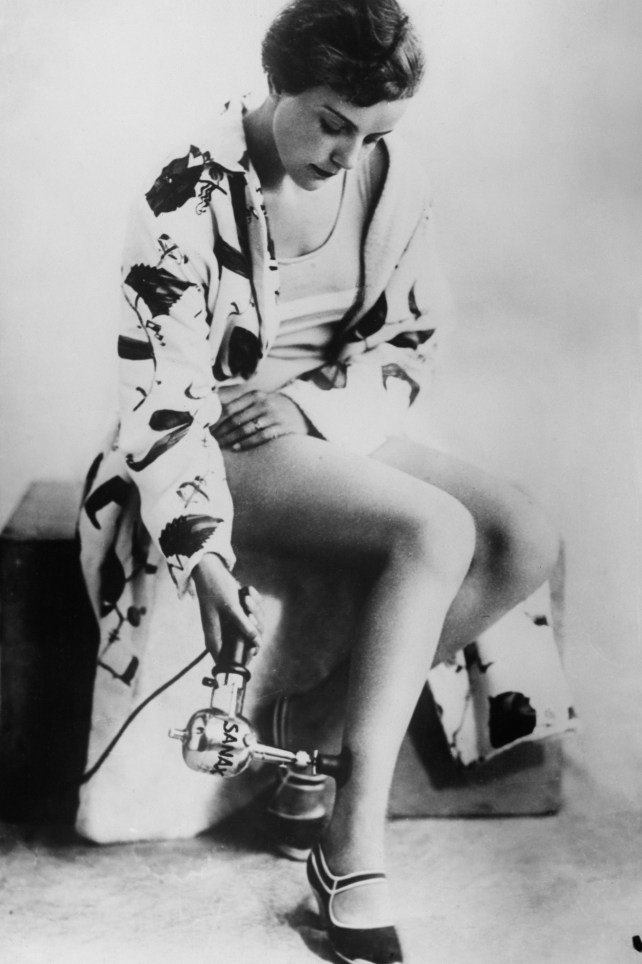
Woman using the Sanax-Vibrator, circa 1925
FPG/Getty
Invigorated, Comstock turns his full attention to “vile weekly newspapers” and “illustrated licentious books” that “flaunt temptation” in the faces of young men. He began a series of raids on stores where obscene literature was sold. Knowing he’d find himself up against police protectionism, he invited a reporter from the Herald Tribune to accompany him. The result was a series of sympathetic articles, the arrest of scores of purveyors, and the arrival in the popular consciousness of the name Anthony Comstock. Flushed with success and unsatisfied with merely shutting down stationery stores and newsstands, Comstock wanted to go to the source, and root out the actual publishers of these works.
Comstock’s fame and infamy ratcheted up in 1872 when he tangled publicly with Woodhull and her sister, Tennessee Claflin. The sisters, in addition to delivering fiery speeches on women’s rights and Free Love, defied convention by running a brokerage office and were already famous as the “Fascinating Financiers.” They published a “radical reformatory paper” called Woodhull and Claflin’s Weekly, full of impassioned writing, mostly their views on the societal limitations imposed upon women.
Comstock had them arrested when they published an article about the sexual indiscretions of the hugely popular Reverend Henry Ward Beecher of Boston. Their purpose was to expose hypocrisy and double standards, but Comstock knew smut when he saw it. And here was his chance to go after the sisters on a technicality: to Comstock and his ilk, talk of women’s rights was clearly a grave threat to morality and decency, with the same potential for damage as dirty pictures and stories—another form of obscenity, really, but unless they uttered certain words, his hands were tied. The Beecher piece gave him the warrant he needed to swoop down for the kill.
He hadn’t counted on the fighting spirit of his feminine adversaries, though, who purposely forewent bail and spent a highly publicized month in jail and who were eventually cleared of the obscenity charges, on grounds that vividly underscored for Comstock one of the many inherent weaknesses of the existing federal anti-obscenity law: The judge ruled that Woodhull and Claflin’s Weekly was a newspaper, and the law, in an egregious oversight, did not include newspapers. It’s easy to imagine the steam coming out of Comstock’s ears.
The press and the satirical cartoonists, meantime, went over the top with glee. It was a delectable circus with a colorful cast of characters—the beautiful scandalous sisters and their supporters in the “Free Lust” (as Comstock called it) movement, their various husbands and lovers, the Rev. Beecher and his supporters and detractors, and Anthony the grim Puritan, among many others. Comstock’s name and lampooned image were now household words. He was loved, he was hated—and he was famous.
By 1872, the YMCA’s Committee for the Suppression of Vice began discreetly funding him after he showed them engraved plates, used in the production of obscene books, which he had bought from the widow of a well-known publisher. These good gentlemen were all for Comstock’s work, but they, prissily, did not want to be publicly associated with his flagrant, aggressive brand of vice-hunting. So they funded him, under the table, and sent him forth.
He was fearless, going deep into the mean streets in pursuit of his quarry. He employed espionage—disguising himself, posing as a customer or pretending to be a helpless staggering drunk. He nabbed a half-dozen publishers this way, destroyed their plates, and had them arrested. And he wasn’t limiting himself to printed matter, plates, woodcuts, French playing cards, and books. Soon Comstock’s net, hauled up and flung open, revealed a new kind of loathsomeness writhing on the deck. The words are his: Indecent rubber articles.
To fully grasp Comstock and his enduring influence, it’s vital to understand that for him—and other neopuritans of the era—the various vices did not exist separately. No sin is an island. The “bleared eye, the bloated face, and the reeling step” of the drunkard are bad, but that’s just the gateway transgression. Drink weakens the will. Next thing you know you’re looking at dirty pictures or reading vile newspapers and engaging in “solitary meditations.” It’s just a short step to the brothel. The ripple effect of unclean thought and behavior, radiating its society-rotting ruin outward to affect innocent bystanders, especially women and children, exactly like putting concentrated poison into the reservoir. The poison, ladies and gentlemen, is lust.
Comstock the moral epidemiologist takes it very, very seriously, and he knows where the trouble begins—with the “cursed business of obscene literature.” It “breeds lust,” and lust, in turn, “defiles the body and debauches the imagination, corrupts the mind, deadens the will, destroys the memory, sears the conscience, hardens the heart and damns the soul.” Eventually it “plunges the victim into practices that he loathes.” Ultimately, “the family is polluted, home desecrated, and each generation born into the world is more and more cursed by the inherited weakness, this harvest of the seed-sowing of the Evil one.”
To Comstock, therefore, the panacea for all societal rot is the eradication of obscenity. This is the literal way to beat back the Devil, to pull him up by his roots, like the heroes of the biblical stories of his childhood. But what, exactly, constitutes obscenity? The courts had by then pretty much defined it as anything suggesting impure and libidinous thoughts, even if that was not the specific intent. A Pennsylvania statute, for example, forbade advertising of remedies for “women’s intimate disorders,” sex-related or not, because such ads would cause images to form in the mind of the beholder, images which would, in turn, lead to those impure and libidinous thoughts.
And this brings us back to those rubber things. You’re probably thinking that he’s referring to sex toys and such. He is, most assuredly. But that’s not all.
Here’s an excerpt from a letter Comstock wrote to his ally Congressman Clinton Merriam of New York when he was trying to drum up support for a stronger anti-obscenity bill. He’s talking about obscene books, and says that wherever you find them, you will “ever find, as almost indispensable, a complete list of indecent rubber articles for masturbation or for the professed prevention of conception.”
There you have it. Dirty books, naughty pictures, dildos, ticklers, and other “masturbatory appliances,” vaginal syringes, “intermediate tegumentary coverings,” abortifacients and “womb veils”—to him, and others of like mind, they were all the same, interlocked gears in the infernal machinery of damnation: Obscene literature and pictures led to immoral behavior, which led to contraception and abortion; the existence of contraception and abortion led to immoral behavior and an escalating appetite for obscene literature. Thus the Devil drags you under. That small string of linked words in Comstock’s letter to the congressman, this utter nondistinction between salacious playthings and birth control devices, sweeping them into one big pile of facilitators of lewd and lascivious thought and behavior, would affect, devastatingly, women’s lives, health and freedom for almost the next 100 years.
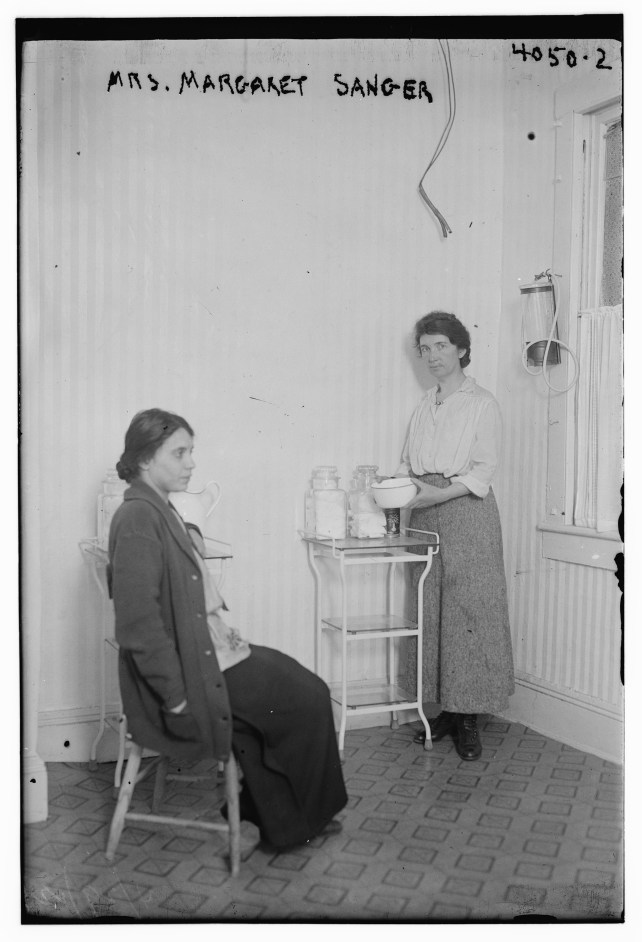
Birth conrol activist Margaret Sanger with Fania Mindell inside Brownsville clinic, probably taken 1916. The clinic was closed nine days after its opening. Sanger was jailed for violating the Comstock obscenity laws.
George Grantham Bain Collection/Library of Congress
Comstock traveled to Washington under the auspices of the Committee for the Suppression of Vice and lobbied intensively to put sharp new teeth into the existing federal anti-obscenity law. The law already forbade the use of the US mail to transport obscene materials. But where it fell grievously short in Comstock’s eyes and in the eyes of his YMCA sponsors was in the definition of what constituted obscenity. Sure, it covered books, pamphlets, and pictures of “a vulgar and indecent” character, but it didn’t include material printed in newspapers, nor did it include those “rubber articles” or advertisements about them, nor did it include ads and info about abortionists and abortifacients. And, unlike an anti-obscenity statute in England, the American federal statute did not allow for search and seizure. Some state and local laws did, but that left huge gaps. Comstock to the rescue. Still smarting, no doubt, from the Woodhull and Claflin affair only a month or so before, he set out for the Capitol in February of 1873.
He carried a sample case with him, the items within surely hand-selected for maximum effect. You can envision him moving around congressional offices, snapping the case open and shut, making his appeal in rapid and practiced tones, black-coated murmuring groups of men closing ranks around him. Yes, you read that right: he brought a case of dildos to Congress. Imagine it: whitish rubber dildos against dark velvet, the pale faces of the congressmen pinkening at the sight, steeling their resolve.
Comstock’s diary shows him praying in his hotel room in an agony of suspense and a desire to submit to the will of God while the bill was being considered. February was almost over, and Congress would soon adjourn. There were possible amendments and delays, and there was a fair amount of opposition—not to mention other hugely important issues before Congress, including a railroad-financing scandal within their own ranks.
But pass it did, at three o’clock in the morning of March 2, 1873. Congressman Merriam took to the House floor and spoke of the “best interests of morality and humanity.” In passing Comstock’s bill, they would be shielding, he told his fellow congressmen, the “beauty and purity of womanhood.”
It sailed through the Senate and was signed into law by President Ulysses S. Grant on March 3 and named after the crusader himself. The Comstock Act had the clout to knock down sinners wherever they scuttled and hid. It contained all the expected language forbidding transport via the mails of books, pamphlets, pictures, etc., along with “any article or thing designed or intended for the prevention of conception or the procuring of abortion” and “any book, pamphlet, advertisement or notice of any kind giving information, directly or indirectly, where, or how, or of whom, or by what means either of the things before mentioned may be obtained or made.”
Since 1860 there had been a steady state-by-state spread of antiabortion legislation. By the time the bill was signed into law, abortion was mostly illegal in the United States, but women’s demand for it remained unchecked, enforcement was spotty and sporadic, and abortionists and purveyors of “remedies” abounded, advertised openly, wriggled in and out of loopholes and sent information through the US mail.
The Comstock Act finally and decisively drove abortion underground, where it stayed for a century. That the vehicle carrying abortion and contraception down into the dark underside of society was anti-obscenity legislation meant that the taint of prurience would cling, and clings to this day.
Not only did Comstock get his federal law, and not only did it bear his name, but he was made a special agent of the US Post Office, with a badge and a free ticket on any rail line to anywhere in the United States and the power to arrest anyone, at any time, who, in his entirely arbitrary opinion, was trafficking in obscenity, and confiscate the “goods.” It should be remembered that Comstock was, at this historic moment, only 29 years old.
And he and his anti-obscenity laws would score many “victories” for the rest of his respectably long life and beyond. Toward the end of his career, he liked to enumerate and inventory his accomplishments, claiming, for instance, to have destroyed 130,000 pounds of books, 60,300 articles “made of rubber for immoral purposes,” 3,150 boxes of “pills and powders used by abortionists,” 20,000 letters from “various parts of the United States ordering improper articles,” and on and on and on.
In 1878, he used his talents as a sting artist against one of New York’s most notorious abortion and contraception providers, “Madame Restell” (real name Ann Summers). Posing as a man seeking birth control for his wife, he went to Madame Restell’s establishment. She gave him pills; he came back the next day with the cops and hauled her in. She committed suicide rather than face a trial.
She was not the only woman driven to self-destruction by Comstock: Ida Craddock, “spiritualist” and advocate of free speech and women’s rights, who also wrote about female sexuality, killed herself in 1902 when faced with further legal troubles after she had already served prison time after being convicted of obscenity. Her crime? Sending a “marriage manual” through the US mail. Her public suicide note specifically condemned Comstock, who had been hounding her for years and who testified against her in Federal Court.
He would later brag that he had driven fifteen people to suicide.
Comstock and the birth-control crusader Margaret Sanger were natural enemies. Working as a visiting nurse in the slums of New York in 1911, she was appalled by the condition of women worn out and torn up from serial childbirth and injured by self-induced abortions. In 1914, she launched a monthly newsletter called The Woman Rebel, which promoted contraception vigorously and sent it via the US mail. She wanted to provoke Comstock. He obliged; she was indicted for violating postal obscenity laws, but avoided trial by fleeing to England. So he had her husband arrested. Comstock died in September of 1915, missing Sanger’s return to New York and the grand opening of her birth control clinic in Brooklyn. He also missed out on the 1916 arrest of feminist and civil rights advocate Emma Goldman while she was giving a lecture in New York on family planning. She, too, had deliberate provocation in mind. Of the Comstock legacy, she said, “When a law has outgrown time and necessity, it must go, and the only way to get rid of the law is to awaken the public to the fact that it has outlived its purpose. And that is precisely what I have been doing and mean to do in the future.”
Gradually, Supreme Court decisions and state laws eroded the power of the Comstock Act. But Dobbs has changed everything. If resurrected, the Comstock Act could trump any state law meant to oppose it, and bar access to mifepristone. And not just mifepristone, but any abortion-related device sent through the mail. And it isn’t just abortion that’s on the line. A rejuvenated Comstock Act could be put to work curtailing contraception and LGBTQ literature and anything else you can think of that might rub the dour moralizers the wrong way.
The Comstock Act appeals to them for the same reason it appealed to its namesake. Sweeping and arbitrary power, moral castigation, and most of all, cruelty. Punishment is the point. Deprive women of chemical abortion, and it will be an inevitable return to hands-on illegal abortion, which is crude, barbaric, sexualized, woman-specific vigilante punishment. And that suits the Puritans just fine.

